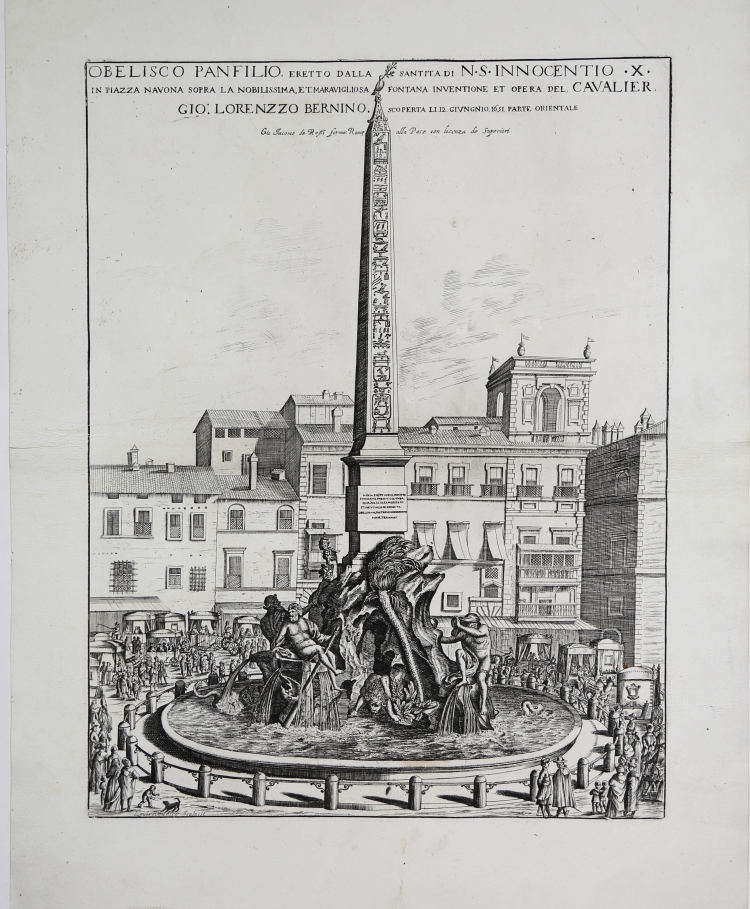



| Reference: | S40611 |
| Author | Louis ROUHIER |
| Year: | 1651 |
| Zone: | Piazza Navona |
| Printed: | Rome |
| Measures: | 370 x 480 mm |


| Reference: | S40611 |
| Author | Louis ROUHIER |
| Year: | 1651 |
| Zone: | Piazza Navona |
| Printed: | Rome |
| Measures: | 370 x 480 mm |
Obelisco Panfilio, eretto dalla santita di n.s. Innocentio. X. in piazza Navona sopra la nobilissima, et maravigliosa fontana inventione et opera del, cavalier. Gio: Lorenzzo Bernino. scoperta li. 12. givngnio. 1651. Parte orientale. Signed at lower left Louis Rouhier sculpsit.
View of the Fountain of the Four Rivers in Piazza Navona. Belong of a pair of views of the west an east side of the Fountain of Four Rivers, signed by the French engraver Louis Rouhier, originally from Dijon but mainly active in Rome, for the publisher Giovan Giacomo de Rossi. The works are made specifically to document the inauguration of Bernini's Fountain of Rivers in Piazza Navona on June 12, 1651. They depict the square and the fountain with a view from the east and one from the west, to show the sculpture in all its extraordinary beauty.
The fountais is made by the Domitian's obelisk, transferred by order of Giambattista Pamphilj or Innocent X, from the Circus of Maxentius to Piazza Navona and integrated by Gianlorenzo Bernini in the design of the Fountain of Four Rivers.
“[…] edita dal De Rossi proprio nel 1651, ci mostra infatti la fontana dei Quattro Fiumi con l'obelisco appena collocato. La data che leggiamo, 12 giugno 1651, è quella del giorno dell’inaugurazione della famosissima scultura che, come è noto, il Bernini realizzò dopo essere caduto in disgrazia presso i Pamphilj; la sua grande fama infatti aveva subito una battuta d'arresto, a seguito dell'insuccesso riportato dal suo campanile in San Pietro e per aver lavorato con la famiglia Barberini, da sempre in antagonismo con quella dei Pamphilj. Fu la cognata donna Olimpia, a sottoporre ad Innocenzo X la visione del modello in argento della fontana del Bernini, che lasció molto favorevolmente impressionato il pontefice, e così l'importante committenza fu affidata allo scultore, il quale elaborò la straordinaria allegoria che voleva esprimere il trionfo della Chiesa cattolica sui quattro continenti simbolizzati dalle personificazioni dei fiumi: Nilo, Gange, Rio della Plata, Danubio. Inevitabile è l'accostamento tra questa incisione e il dipinto conservato presso il Museo di Roma (inv. MR 35459) che però sembra riferirsi ad una visita "informale" effettuata dal pontefice qualche giorno prima dell'inaugurazione e precisamente, l'8 giugno 1651. L'acquaforte offre una piacevolissima scena di vita romana fornendo una puntuale riproduzione dei costumi dei personaggi raffigurati nelle loro carrozze o nell'atto di contemplare la nuova, meravigliosa creazione” (cf. Simonetta Tozzi, in Incisioni barocche di Feste e avvenimenti, pp. 179-182, IV.9).
“In a pair of prints etched by Louis Rouhier and published by Giovanni Giacomo de Rossi, the space is forged as public through the specificities of time and space. Access to the fountain is now extended over two images, and this is just one of the ways in which the prints seek to bring a new approach to visuality within public space. In each, the fountain defines the field of vision, taking in the most concentrated views of its own world geography as well as all the parts of the surrounding buildings that such viewpoints might reveal. These are rendered in exacting topographical vocabulary and become part of the ways the eye is not allowed to settle on an overall shape but is kept constantly on the move. This movement might start from the fountain to take in all of its details and its attentive and enthusiastic promenaders and then progress upward toward the height of the obelisk, finally reaching the surmounting Pamphili dove holding an olive branch. In other words, the earlier coherence of the space is replaced with an eye that penetrates the space activated by the visual power of the fountain. Thus instead of being conceptualized by what is lacking, the piazza is conceprualized by what fills it. In fact, the desire is to fill, and constantly refill, the Space. It is filled with gushing water, rhetorical bodily gestures, the flora and fauna of the world at large, the continuous movement of people around the fountain, and even time, be it back to antiquiry pace seem all too empty, this one seems astonishingly full. Visual observation is what fills the space, supplying it with a new order, new boundies, and a new public” (cf. Rose Marie San Juan, A City out of Print, pp. 207-209, fig. 6.9, 6.10).
Second printing of the plate, entirely retouched by burin, still with the address of Giovanni Giacomo de Rossi but printed towards the end of the 17th century. Beautiful proof, with wide margins, traces of restoration and glue visible on the verso in the central part, otherwise in good condition.
Literature
S. Tozzi, pp. 179-182, IV.9; R. M. San Juan, pp. 207-209, fig. 6.9, 6.10; Fagioli, Carandini (1978). p. 173.
Louis ROUHIER (attivo a Roma intorno al 1650)
|
An engraver from Dijon who had settled in Rome around 1650.
|
Louis ROUHIER (attivo a Roma intorno al 1650)
|
An engraver from Dijon who had settled in Rome around 1650.
|